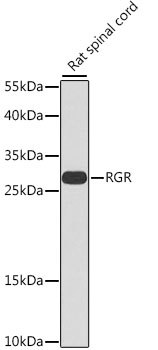Signal Transduction Antibodies 3
Anti-RGR Antibody (CAB7925)
- SKU:
- CAB7925
- Product Type:
- Antibody
- Reactivity:
- Rat
- Host Species:
- Rabbit
- Isotype:
- IgG
- Antibody Type:
- Polyclonal Antibody
- Research Area:
- Signal Transduction
Description
| Antibody Name: | Anti-RGR Antibody |
| Antibody SKU: | CAB7925 |
| Antibody Size: | 20uL, 50uL, 100uL |
| Application: | WB |
| Reactivity: | Rat |
| Host Species: | Rabbit |
| Immunogen: | Recombinant fusion protein containing a sequence corresponding to amino acids 156-295 of human RGR (NP_002912.2). |
| Application: | WB |
| Recommended Dilution: | WB 1:500 - 1:2000 |
| Reactivity: | Rat |
| Positive Samples: | rat spinal cord |
| Immunogen: | Recombinant fusion protein containing a sequence corresponding to amino acids 156-295 of human RGR (NP_002912.2). |
| Purification Method: | Affinity purification |
| Storage Buffer: | Store at -20'C. Avoid freeze / thaw cycles. Buffer: PBS with 0.02% sodium azide, 50% glycerol, pH7.3. |
| Isotype: | IgG |
| Sequence: | HYDY EPLG TCCT LDYS KGDR NFTS FLFT MSFF NFAM PLFI TITS YSLM EQKL GKSG HLQV NTTL PART LLLG WGPY AILY LYAV IADV TSIS PKLQ MVPA LIAK MVPT INAI NYAL GNEM VCRG IWQC LSPQ KREK DRTK |
| Gene ID: | 5995 |
| Uniprot: | P47804 |
| Cellular Location: | Membrane, Multi-pass membrane protein |
| Calculated MW: | 27kDa/31kDa/32kDa |
| Observed MW: | 32kDa |
| Synonyms: | RGR, RP44 |
| Background: | This gene encodes a putative retinal G-protein coupled receptor. The gene is a member of the opsin subfamily of the 7 transmembrane, G-protein coupled receptor 1 family. Like other opsins which bind retinaldehyde, it contains a conserved lysine residue in the seventh transmembrane domain. The protein acts as a photoisomerase to catalyze the conversion of all-trans-retinal to 11-cis-retinal. The reverse isomerization occurs with rhodopsin in retinal photoreceptor cells. The protein is exclusively expressed in tissue adjacent to retinal photoreceptor cells, the retinal pigment epithelium and Mueller cells. This gene may be associated with autosomal recessive and autosomal dominant retinitis pigmentosa (arRP and adRP, respectively). Alternative splicing results in multiple transcript variants encoding different isoforms. |
| UniProt Protein Function: | RGR: Receptor for all-trans- and 11-cis-retinal. Binds preferentially to the former and may catalyze the isomerization of the chromophore by a retinochrome-like mechanism. Defects in RGR are the cause of retinitis pigmentosa type 44 (RP44). RP44 is a retinal dystrophy belonging to the group of pigmentary retinopathies. Retinitis pigmentosa is characterized by retinal pigment deposits visible on fundus examination and primary loss of rod photoreceptor cells followed by secondary loss of cone photoreceptors. Patients typically have night vision blindness and loss of midperipheral visual field. As their condition progresses, they lose their far peripheral visual field and eventually central vision as well. Belongs to the G-protein coupled receptor 1 family. Opsin subfamily. 3 isoforms of the human protein are produced by alternative splicing. |
| UniProt Protein Details: | Protein type:GPCR, family 1; Receptor, GPCR; Membrane protein, integral; Membrane protein, multi-pass Chromosomal Location of Human Ortholog: 10q23 Cellular Component: integral to plasma membrane Molecular Function:G-protein coupled receptor activity; protein binding; chemokine receptor activity; photoreceptor activity Biological Process: G-protein coupled receptor protein signaling pathway; visual perception; phototransduction; chemotaxis; protein-chromophore linkage Disease: Retinitis Pigmentosa 44 |
| NCBI Summary: | This gene encodes a putative retinal G-protein coupled receptor. The gene is a member of the opsin subfamily of the 7 transmembrane, G-protein coupled receptor 1 family. Like other opsins which bind retinaldehyde, it contains a conserved lysine residue in the seventh transmembrane domain. The protein acts as a photoisomerase to catalyze the conversion of all-trans-retinal to 11-cis-retinal. The reverse isomerization occurs with rhodopsin in retinal photoreceptor cells. The protein is exclusively expressed in tissue adjacent to retinal photoreceptor cells, the retinal pigment epithelium and Mueller cells. This gene may be associated with autosomal recessive and autosomal dominant retinitis pigmentosa (arRP and adRP, respectively). Alternative splicing results in multiple transcript variants encoding different isoforms. [provided by RefSeq, Jul 2008] |
| UniProt Code: | P47804 |
| NCBI GenInfo Identifier: | 1350592 |
| NCBI Gene ID: | 5995 |
| NCBI Accession: | P47804.1 |
| UniProt Secondary Accession: | P47804,Q96FC5, A6NKK7, |
| UniProt Related Accession: | P47804 |
| Molecular Weight: | 291 |
| NCBI Full Name: | RPE-retinal G protein-coupled receptor |
| NCBI Synonym Full Names: | retinal G protein coupled receptor |
| NCBI Official Symbol: | RGR |
| NCBI Official Synonym Symbols: | RP44 |
| NCBI Protein Information: | RPE-retinal G protein-coupled receptor; RGR-opsin; RPE retinal G-protein coupled receptor |
| UniProt Protein Name: | RPE-retinal G protein-coupled receptor |
| Protein Family: | RPE-retinal G protein-coupled receptor |
| UniProt Gene Name: | RGR |
| UniProt Entry Name: | RGR_HUMAN |
View AllClose







